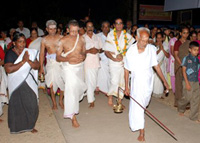
Significance Of 36 Pradakshinas
A temple of an area is designed to shower prosperity and wellbeing to the surroundings and people living in its vicinity. The concept of temple worship originates from Mantra sadhana, which is an integral part of spirituality, which in turn originates from Yoga sasthra and Thantra sasthra stipulated by spiritually realized Yogis and Maharshis for the common men from time immemorial. Thus a common devotee while visiting a temple is expected to do pradakshina (circumbulance) to the deity as an important part of the visit. The word pradakshina is formed by the letters PRA (which denotes removal of all fears), DA (meaning achievement of moksha or salvation), KSHI (freeing from all diseases) and NA (denoting prosperity). Pradakshinam is considered as one of the most important physical offering a devotee can do with his body; anyone can offer it to the Lord exclusively using one’s mind and body unconditionally and with no other means required.
The word pradakshina is formed by the letters PRA (which denotes removal of all fears), DA (meaning achievement of moksha or salvation), KSHI (freeing from all diseases) and NA (denoting prosperity). Pradakshinam is considered as one of the most important physical offering a devotee can do with his body; anyone can offer it to the Lord exclusively using one’s mind and body unconditionally and with no other means required.
 The ultimate aim of all spiritual practices included in the ancient Indian spiritual culture is to bring out the limitless possibilities and divine power inherent in man. This sleeping divine power, called Kundalini, when awakened through Yoga or other stringent spiritual practices, will apparently lead one to salvation or freedom from all worldly ailments and miseries. This, as per Rishis and Yogis, must be the only goal of leading a human life with all its special powers of intellect and mind unavailable in other forms of life. Realization of this state is called Moksha or Salvation. By doing pradakshinas, a common devotee knowingly or unknowingly, triggers the awakening of the power of Kundalini within him and gradually through further spiritual practices, It goes up from its sleeping posture( in the middle of the physical body) towards the Ajna Chakra in the head, breaking through the other four chakras in its upward journey, leading one to Salvation.
The ultimate aim of all spiritual practices included in the ancient Indian spiritual culture is to bring out the limitless possibilities and divine power inherent in man. This sleeping divine power, called Kundalini, when awakened through Yoga or other stringent spiritual practices, will apparently lead one to salvation or freedom from all worldly ailments and miseries. This, as per Rishis and Yogis, must be the only goal of leading a human life with all its special powers of intellect and mind unavailable in other forms of life. Realization of this state is called Moksha or Salvation. By doing pradakshinas, a common devotee knowingly or unknowingly, triggers the awakening of the power of Kundalini within him and gradually through further spiritual practices, It goes up from its sleeping posture( in the middle of the physical body) towards the Ajna Chakra in the head, breaking through the other four chakras in its upward journey, leading one to Salvation.
The principles or characteristics on which Nature exists are known as Thatwas. The 36 Siva thatwas are denoted by 36 beejakshara manthras (or letters) and the famous Panchakshari mantra (Namassivaya) forms the centre of them. While originally installing the deity as per Thantra shastra, the Thantri (chief priest) used these 36 beejakshara mantras, denoting the Siva thatwas (known as Shadthrimshathi thatwas) and the power of the deity is mainly based on this mantra. These mantras are also recited while doing special poojas and also at the time of yearly kalashabhishekam (to empower the deity).
 Thus, at Sri Chandrasekharapuram temple, after installing the deity more than a century ago, ”doing 36 pradakshinas with Panchakshari” was prescribed by the Chief Priest (Thantri) as a very significant offering to the Lord. By offering 36 pradakshina (along with chanting of the Panchakshari) to the deity of Lord Siva at Sri Chandrasekharapuram Temple, therefore, a devotee is in fact doing a very important spiritual practice in order to awaken his inherent divine power ultimately leading to salvation...Namassivaya
Thus, at Sri Chandrasekharapuram temple, after installing the deity more than a century ago, ”doing 36 pradakshinas with Panchakshari” was prescribed by the Chief Priest (Thantri) as a very significant offering to the Lord. By offering 36 pradakshina (along with chanting of the Panchakshari) to the deity of Lord Siva at Sri Chandrasekharapuram Temple, therefore, a devotee is in fact doing a very important spiritual practice in order to awaken his inherent divine power ultimately leading to salvation...Namassivaya
 Home
Home